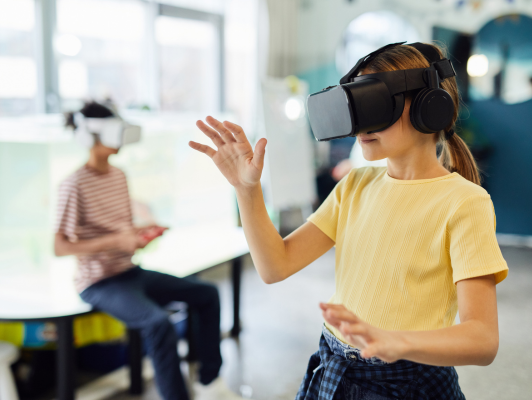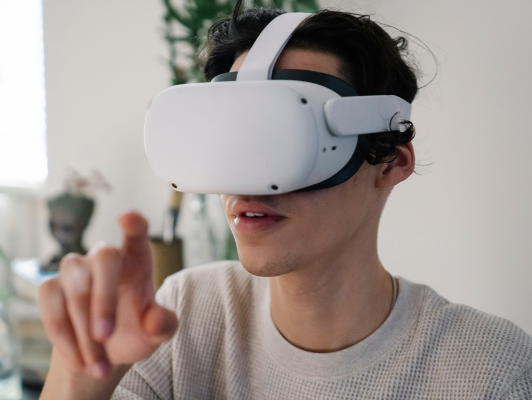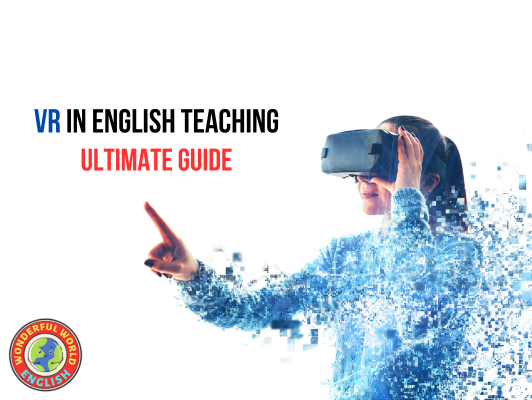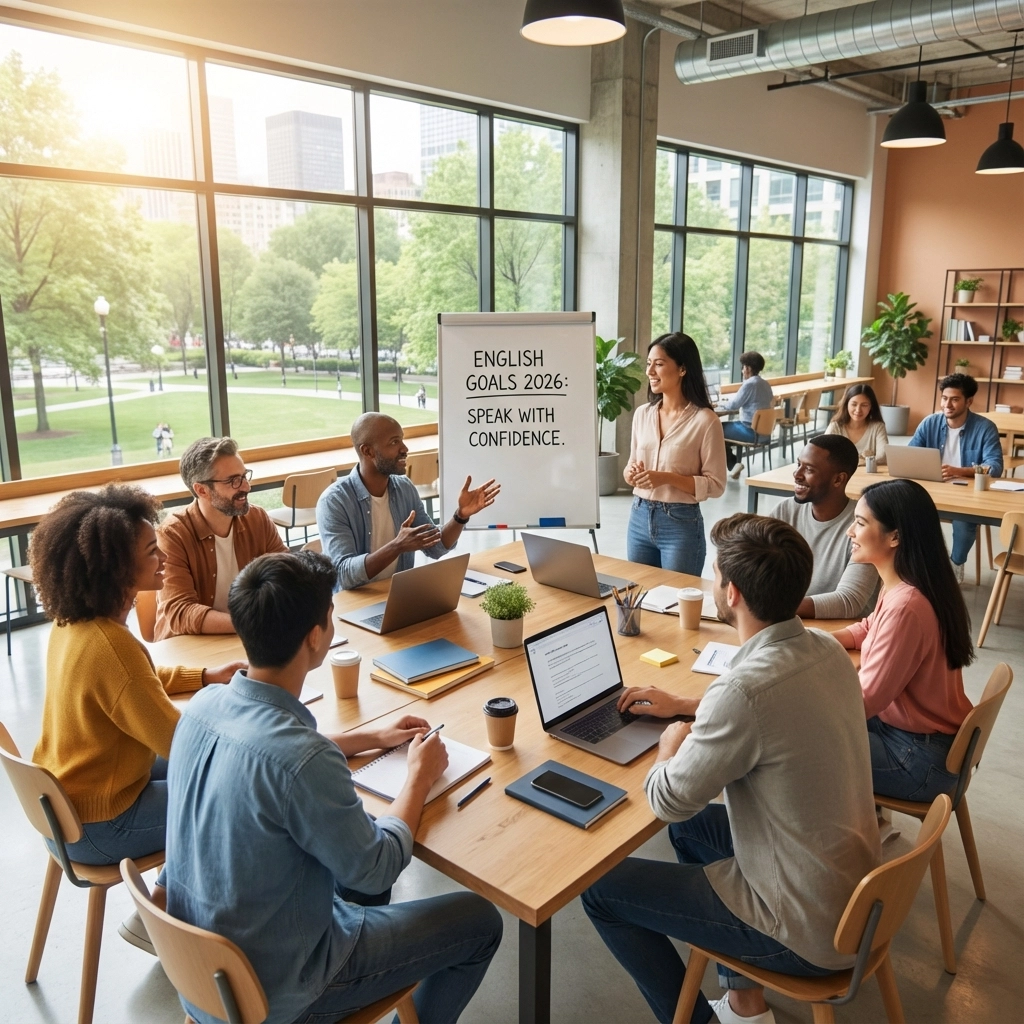Contents
Toggle
Meet David De’ Ath, founder, editor, and writer at Wonderful World English. With his extensive background as an English teacher, David provides valuable insights and practical tips on ESL for students and teachers alike.
The introduction of Virtual Reality (VR) into English Language Teaching (ELT) marks the beginning of a revolutionary shift in how languages are taught and learned.
This innovative technology is steering the educational landscape toward an era of enhanced interactivity and immersive learning experiences for students everywhere.
As we unpack the layers of VR in ELT, this guide serves as a pathway for teachers to explore VR’s vast potential. VR offers interactive, realistic virtual environments, enhancing student engagement and skill practice. This technology transforms traditional methods, broadening learning possibilities and aligning with modern trends.
We will provide a detailed overview of the various applications of VR in language learning and offer practical insights and strategies for integrating VR into teaching.
By diving deep into the practicalities and possibilities of VR, teachers are offered a valuable resource to understand and effectively implement this advanced technology in their teaching.
We aim to empower teachers with the knowledge and tools necessary to confidently navigate this new technological frontier, ultimately enhancing their teaching strategies and enriching the language learning experience for their students.

VR in English Teaching
In ELT, Virtual Reality uses simulated environments to make learning more engaging.
VR ranges from fully immersive digital experiences to augmented reality (AR), which blends digital elements with the real world.
This approach creates an interactive and stimulating learning experience, allowing students to explore the English language in a fun and innovative way.
It offers new and exciting opportunities for language learning, making it more immersive and enjoyable.
Let’s take a closer look at the benefits of VR in English teaching.
Benefits of VR in English Teaching
Virtual Reality in language education offers a multitude of benefits that enhance and transform the learning experience.
The ten greatest benefits that can come from using VR when teaching English are as follows:
1) Vocabulary Enhancement
VR’s immersive environments are rich in context, helping learners absorb new vocabulary naturally.
Young learners, in particular, find these settings captivating, as they can see and interact with objects and scenarios that embody the new words, making learning more intuitive and memorable.
2) Immersive Learning Experience
VR allows learners to be ‘transported’ to different settings where they can experience language use in various real-life situations.
Whether it’s navigating a busy city or ordering food in a restaurant, this realistic practice leads to a deeper understanding and better retention of language structures and vocabulary.
Along with VR, we have also seen great strides in Artificial intelligence (AI) in recent months.
For a list of the best AI-powered tools to enhance English language learning, check out the link below!
Related Article: Best AI-Powered Tools for Learning English (Top 5)
3) Enhanced Engagement and Motivation
VR’s novelty and interactive nature capture learners’ attention, boosting their engagement with the material.
This increased interest often leads to higher motivation levels, as students are eager to explore and learn in these captivating virtual worlds.
This can be especially helpful when teaching some of the more mundane aspects of the language and student disengagement is at its highest.

4) Improved Listening and Speaking Skills
In VR, students can engage in conversations and listen to native speakers in a wide range of scenarios.
This exposure is invaluable for developing listening comprehension and spoken language skills, particularly for those who cannot interact with native speakers in their everyday lives.
5) Cultural Immersion
VR can simulate environments from around the world, allowing learners to immerse themselves in the culture related to the language they are studying.
Whether in the busy streets of London or New York or at a supermarket in some other English-speaking part of the world, being immersed in these environments will give students an excellent chance to absorb and practice.
This exposure helps understand cultural references, idiomatic expressions, and the social context of language, which is crucial for language fluency.
6) Increased Confidence
Learning in a VR environment can be less daunting than real-world interactions, allowing learners to practice and make mistakes without the fear of judgment.
This can significantly reduce language anxiety and build confidence in their language abilities.
7) Personalized Learning Experiences
VR technology can adapt to different learning styles and proficiency levels, offering personalized learning paths.
This means lessons can be tailored to address each learner’s specific needs, strengths, and weaknesses, making the learning process more efficient and effective.

8) Immediate Feedback and Correction
Many VR language learning applications are designed to provide immediate feedback.
This feature helps learners quickly identify and correct their mistakes, which is a key factor in effective language learning.
Chat-GPT can serve as an excellent tool for teachers and students involved in English education.
For a complete guide on this, click the link below!
Related Article: ChatGPT & English Learning: A Teacher’s Guide
9) Enhanced Memory Retention
The multisensory experience in VR, where learners can see, hear, and interact with the language in a 3D space, leads to better memory retention.
The more engaged and active the learner is, the more likely they are to remember what they’ve learned.
10) Scalability and Accessibility
VR can make high-quality language learning experiences accessible to a wider audience, including those in remote or less resource-rich areas.
It offers a scalable solution to bring immersive language learning to more people, breaking down geographical and socio-economic barriers.
This array of advantages showcases VR’s potential to revolutionize language learning.
However, it’s essential to balance these positives with some considerations.
Let’s now look at some of the challenges of VR in language education and how to overcome them.

Challenges of VR in English Teaching
As with all things in life, there are challenges to overcome.
Fortunately, there are ways teachers can minimize any risks associated with VR by taking extra precautions and care in their implementation of it in their lesson plans.
Let’s take a closer look at four challenges associated with VR in English teaching:
1) Overcoming Technological Hurdles with Simplicity
Current VR applications in classrooms have limitations.
A practical solution is to start with simpler VR tools like 360° videos, offering an easier entry into VR without needing advanced hardware or software.
This helps educators introduce VR effectively, reducing complexity.
2) Accessibility and Adhering to Health Protocols
Post-pandemic, accessibility of VR devices is crucial.
These tools must be reachable for all students, regardless of their background or access to technology.
Health protocols for shared VR equipment, including regular sanitization and hygiene standards, are essential for a safe learning environment.
Click here for a complete Virtual Reality Health & Safety Usage Guide.
3) Integration with Curriculum
Properly aligning VR with the curriculum and learning outcomes is challenging.
VR activities need to be relevant and enhance educational goals, requiring careful planning by teachers.
For a helpful guide on how to effectively plan a lesson, check out the link below!
Related Article: How to Lesson Plan for New Teachers – Free Guide
4) Balancing Screen Time
VR involves considerable screen time, raising concerns about its impact on student’s health, particularly vision, and attention.
Teachers need to balance VR use with other teaching methods, ensuring students aren’t overwhelmed by VR and its negative effects on their eye health.

Preparing for the Future of VR
Integrating VR into teacher training becomes imperative as we enter a new educational technology era.
This integration is key to familiarizing educators with the nuances of VR tools and methodologies.
By incorporating VR into their training programs, teachers are empowered to explore and adopt creative approaches to lesson planning.
Designing VR-based lessons is not just about using new technology; it’s about rethinking the learning experience to promote more active, engaging, and student-centered education.
This shift towards VR in teacher training underlines a commitment to innovative teaching practices, ensuring teachers are well-equipped to lead their students into a future where digital and virtual learning environments become increasingly prevalent.
1) Equipping Teachers for the VR Revolution
Integrating VR into teacher training is a critical step toward preparing educators for a future that embraces advanced technology in teaching.
This integration is essential for familiarizing teachers with VR tools and methods and inspiring them to craft innovative, VR-based lesson plans.
Such training encourages educators to think creatively and design more engaging and interactive lessons, promoting an environment of active learning.
By doing so, teachers can significantly enhance student engagement and participation in the classroom.
This shift towards incorporating VR in teacher training underscores a commitment to keeping pace with technological advancements and leveraging them to enrich the educational experience for teachers and students.
2) Anticipating Emerging Trends in VR-Enhanced Education
As we look to the future of educational technology, task-based VR learning activities are set to take center stage, particularly those that focus on real-world applications and cater to student interests.
These VR-driven activities are anticipated to become a significant trend, revolutionizing how educational content is delivered and experienced.
For instance, innovative tasks such as app development or designing virtual escape rooms, when incorporated into VR environments, offer students a deep dive into practical applications and an engaging, interactive learning journey.
This trend signals a shift towards more immersive, hands-on educational experiences that resonate with students on a personal level and equip them with relevant skills and knowledge for the digital age.
Such advancements in VR technology in education indicate a future where learning transcends traditional boundaries, offering richer, more dynamic educational experiences for students of all backgrounds and abilities.
VR will be expected to work alongside AI to provide an immersive learning experience.
For insights into the future of language learning and AI, check out the guide below!
Related Article: AI and the Future of English Language Learning: Insights

Conclusion
Integrating VR in English Language Teaching presents a groundbreaking opportunity to redefine the language education landscape.
This technological innovation offers a pathway to transform traditional language learning methodologies into more dynamic, engaging, and practical experiences.
While there are challenges to overcome, including technological constraints and the need for strategic implementation, the creative application of VR holds the promise of revolutionizing ELT.
By embracing VR, educators can unlock new potential in teaching methods, making language learning more immersive and more aligned with the digital era’s evolving educational needs.
This shift towards VR-enhanced ELT is about reshaping the way we understand and engage with language learning in the 21st century.
We are hopeful about the future of English learning and hope you are too!
Have a wonderful day.
Image Attribution: All images licensed via canva.com





